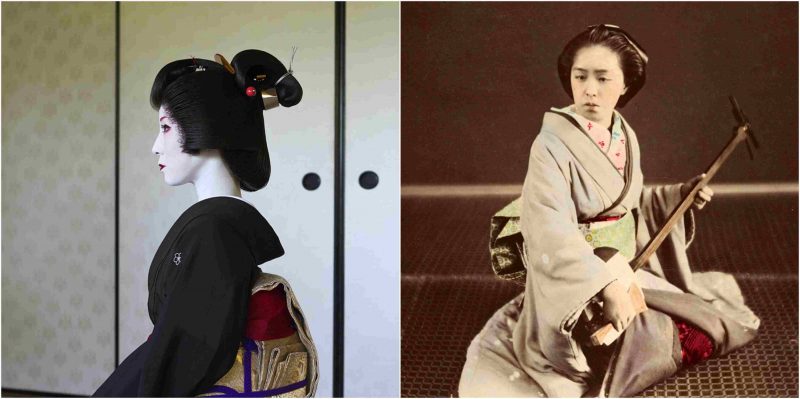The word Geisha roughly translates to “arts person.” Geiko is generally used for geisha from Kyoto and Maiko means “dancing girl” and is generally used for apprentice geisha.
In Tokyo, an apprentice Geisha is called a Hangyoku. In Kyoto, the apprentice for Geisha is called Maiko. Geisha is a female Japanese entertainer and hostess that is easily recognizable by her hairstyle and makeup. They are trained and highly skilled in entertaining male customers with classical music, dance and games.

All apprentice Geisha wear the full white face makeup, while established Geisha only wear the full white makeup during special performances. The apprentice wears a traditional face of white with red lipstick, with black & red around her eyes and eyebrows.
When the makeup practice started, the white base was made with lead in it. When the discovery was made that lead caused health problems, the white base was then made with rice powder.
The makeup application is extremely difficult to perfect and time-consuming, that is one reason that the makeup is applied before putting on the kimono. The other reason is to keep the kimono from getting dirty.
The first thing they put on their skin, is a wax or oil substance called bintsuke-abura.
Then, white powder is mixed with water and applied to the skin with a bamboo brush starting at the neck and working upward. The white covers the chest, neck and face, leaving either a W or V shaped area uncovered on the nape to accentuate this generally erotic area.
Also, a line around the face is left to make it look like they are wearing a mask.
Sometimes Maiko who are in their last stages of training color their teeth black for a brief time.
Married women in Japan and even earlier at the imperial court, this used to be a common practice for them, but now it is only used in some districts.
The reason behind this practice is because the un-colored teeth look yellow compared to the white mask; coloring the teeth make them disappear in the darkness of the open mouth. Throughout history, the hairstyles of the Geisha have varied.
In some periods of the past, women wore their hair down and in others they wore it up. The typical shimada hairstyle that we associate with the Geisha, is that their hair is up on the head in a type of chignon that was developed by the Geisha in the 17th century.

The first hairstyle, Ware-shinobu, was designed to be complex and emphasize the beauty of the Maiko. The Mishidashi-A ware-shinobu, a hairstyle with special kanzashi (hair ornaments), was worn specifically for a Maiko’s debut. The Ofuku, or the ‘split peach’ style, was worn after a level of maturity was attained.
In the back of the bun, the color is changed to match her changing of age.
The splash of red (no longer red and white) is meant to be suggestive and the types of hair decorations must change to match the hairstyle.
The Yakko-shimada was a formal hairstyle worn for dance recitals; this used to be a common hair style for married women. The Katsuyama-a was a special hair style worn for the dance recital (cherry dance) season.
The Sakko was the hair style worn for the final two months of a Maiko’s apprenticeship. Her hair ornaments must now be subtler though still more daring than those of the Geisha.
Kimonos were always worn by Geisha. The apprentice would always be in a highly colorful kimono with an over-the-top obi. To give the kimono an exotic balance, the obi would be much brighter than the kimono.
In Kyoto, the Maiko wore the obi tied in a style called the darai (dangling obi), while in Tokyo, the Hangyoku wear it tied in different ways. The older the Geisha gets, the subtler the kimono and obi get. Married women use a simpler knot in their obi than others.

The kimono worn by the apprentice Geisha, would have sleeves with pockets that hung to the ground. During their performances, the apprentice must wrap the sleeves around her arms to keep from tripping.
The seasons determine what color, style, and pattern of kimono the Geisha will wear to any event. During colder seasons, they are lined and in warmer seasons are unlined.
From our archives: The Napoleon Diamond Necklace – Napoleon’s gift to his second wife, Marie Louise
Each kimono takes anywhere from two to three years to make depending on the painting and embroidering.
